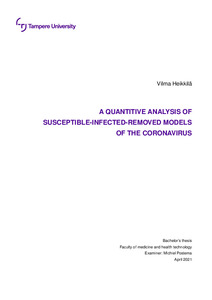A quantitative analysis of Susceptible-Infected-Removed models of the coronavirus
Heikkilä, Vilma (2021)
Heikkilä, Vilma
2021
Bioteknologian ja biolääketieteen tekniikan kandidaattiohjelma - Bachelor's Programme in Biotechnology and Biomedical Engineering
Lääketieteen ja terveysteknologian tiedekunta - Faculty of Medicine and Health Technology
This publication is copyrighted. You may download, display and print it for Your own personal use. Commercial use is prohibited.
Hyväksymispäivämäärä
2021-05-04
Julkaisun pysyvä osoite on
https://urn.fi/URN:NBN:fi:tuni-202104273808
https://urn.fi/URN:NBN:fi:tuni-202104273808
Tiivistelmä
Modelling the susceptibility, infection, and recovery of populations with regards to the COVID-19 pandemic is highly relevant for the implementation of countermeasures by governing bodies. Between January 1st 2020 and March 1st 2021, 13,076 COVID-19 modelling related publications were recorded in the PubMed (R) (National Center for Biotechnology Information of the National Library of Medicine) database. This study was conducted to assess the tools for modelling the spread of the virus. To achieve a view of the current scope of mathematical models, a selection of Susceptible-Infected-Recovered models with a focus on parameter choices was collected and quantitatively analyzed.
The models varied from simple to highly complex, with the number of used parameters ranging from one to 18. Many models included additional compartments to account for the shortcomings of a classical SIR model, but the majority also did not consider essential characteristics of the virus, such as a temporary immunity or mutated virus variants.
The models varied from simple to highly complex, with the number of used parameters ranging from one to 18. Many models included additional compartments to account for the shortcomings of a classical SIR model, but the majority also did not consider essential characteristics of the virus, such as a temporary immunity or mutated virus variants.
Kokoelmat
- Kandidaatintutkielmat [7052]
